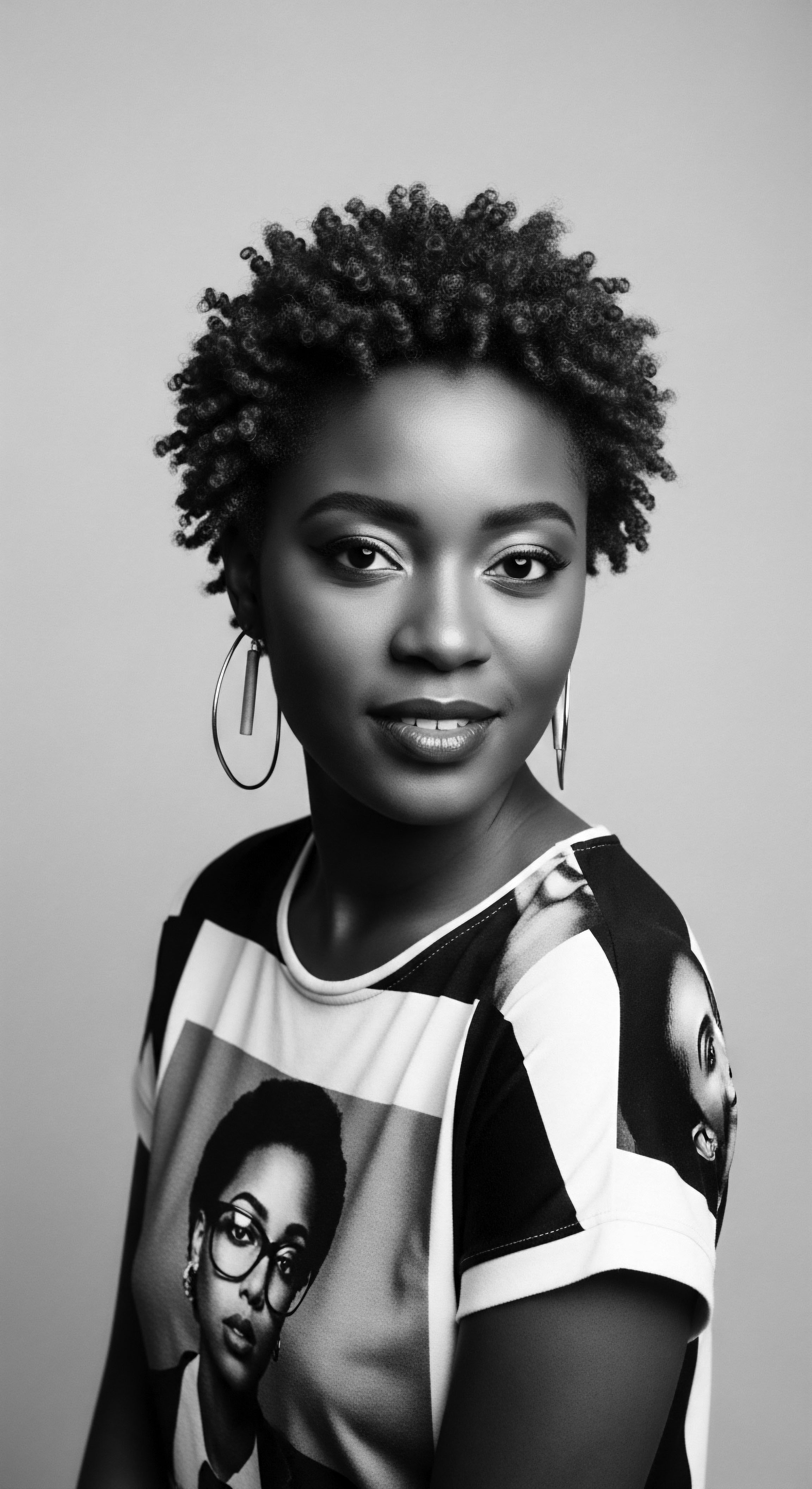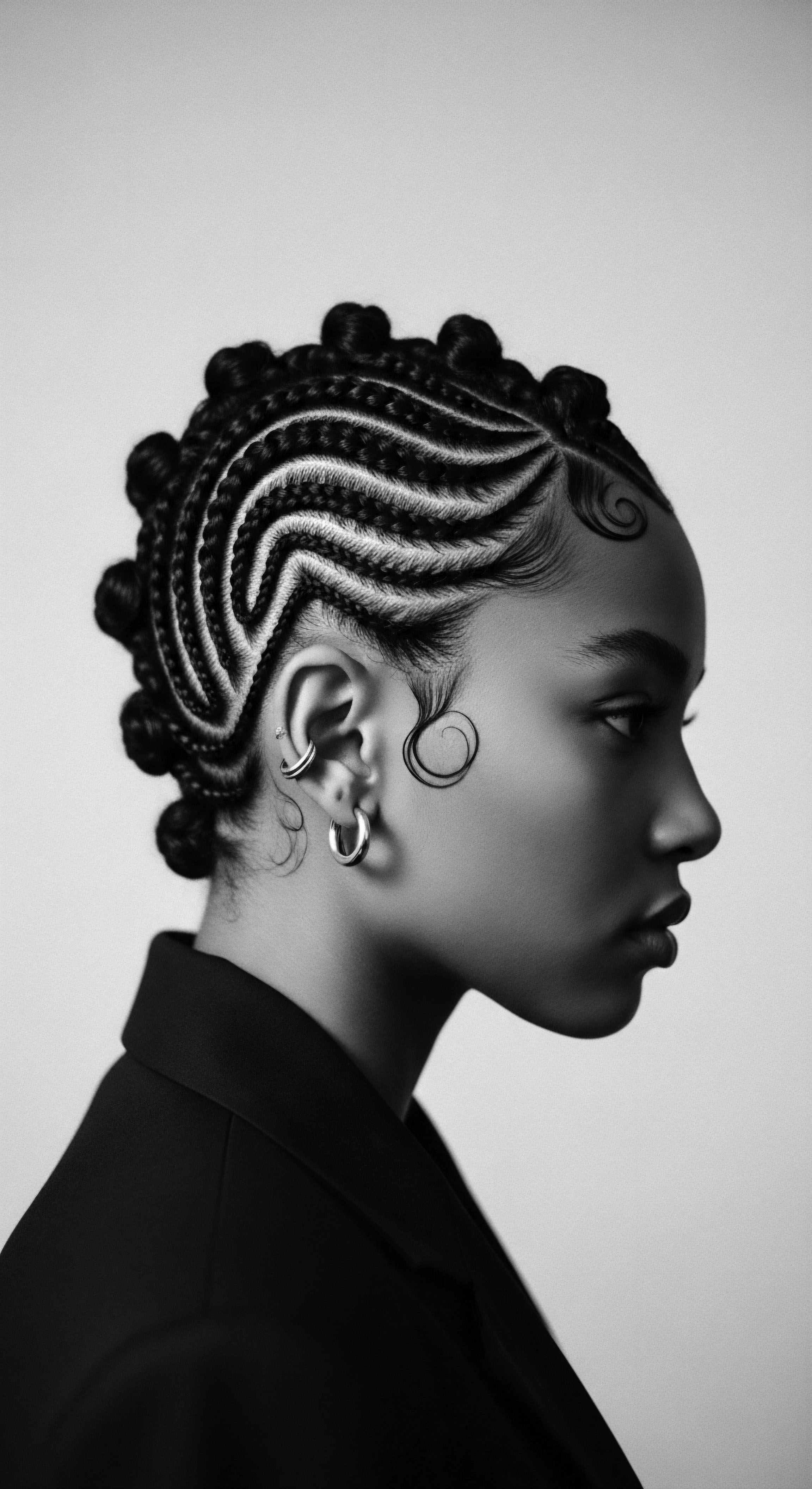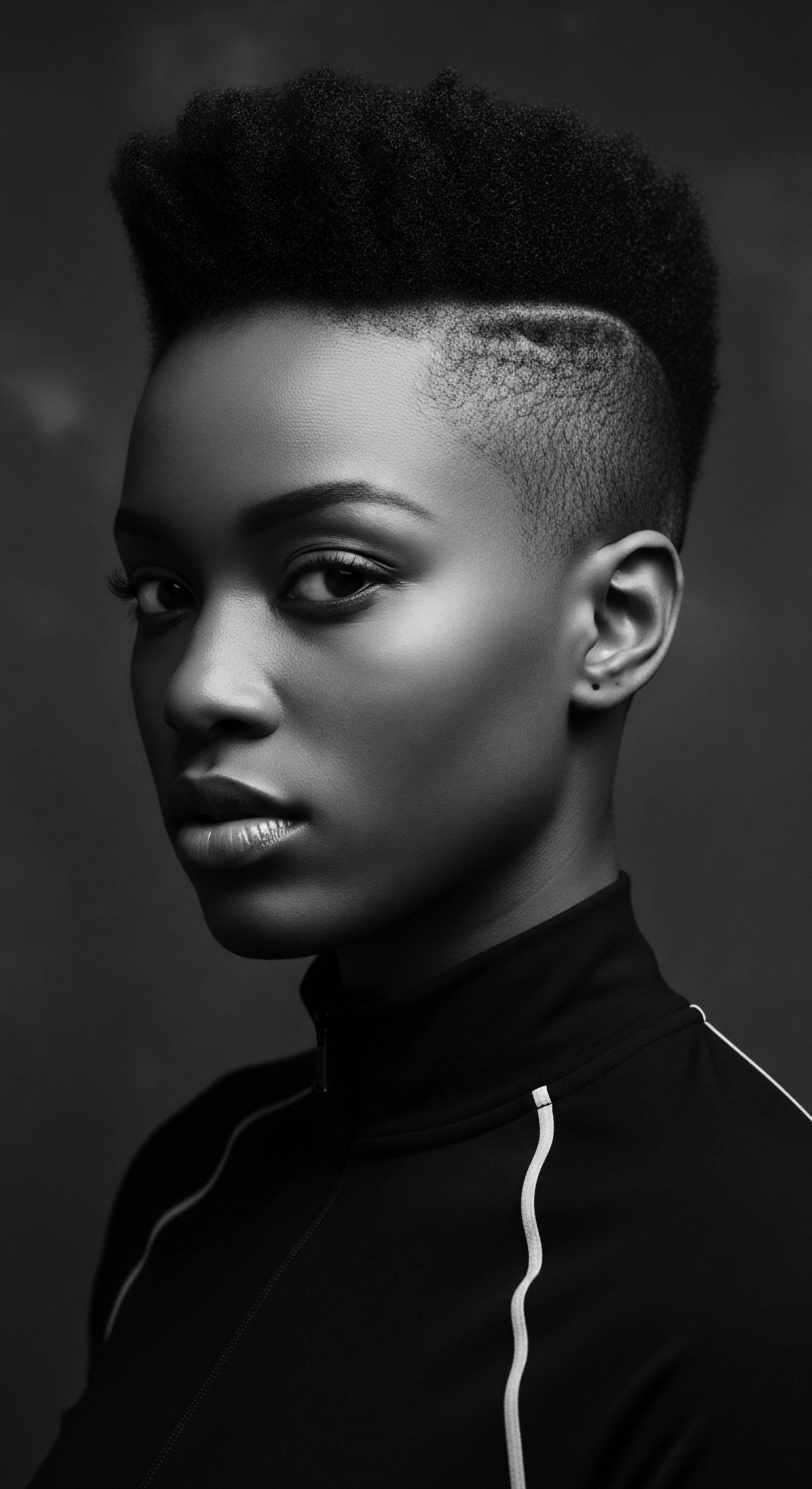
Roots
Have you ever felt a whisper on your scalp, a gentle tugging at your coils, that seems to reach beyond the present moment? It is the ancestral memory of strands, a collective consciousness woven into the very fabric of textured hair. This memory speaks of resilience, of wisdom passed down through generations, and of a profound connection to the earth itself. Our hair, a living crown, carries the echoes of countless hands that have tended it, countless rituals that have celebrated it.
Within this sacred inheritance lies the enduring power of historical plant ingredients, still vibrant, still potent, offering their gifts to the textured hair of today. To truly grasp their ongoing relevance, we must first journey back, tracing the biological tapestry of textured hair and the foundational knowledge that informed ancient care practices.

Anatomy and Ancestral Understanding of Textured Hair
The unique architecture of textured hair, with its elliptical follicle, varied curl patterns, and numerous cuticle layers, grants it both magnificent versatility and particular needs. For centuries, before the advent of modern microscopy, communities understood this intuitively. They knew, through observation and inherited wisdom, that these strands thirsted for moisture and sought gentle handling.
They recognized that the natural oils produced by the scalp, while precious, often struggled to travel the spiraling path from root to tip, leaving the ends vulnerable. This elemental understanding of textured hair’s thirst and fragility was not articulated in scientific journals, but in the tender practices of communal grooming sessions and the careful selection of botanical allies.
Consider the deep-rooted knowledge of how environmental factors, from arid climates to humid coastal lands, influenced hair’s condition. Ancestors in regions like West Africa observed how intense sun and dry winds affected their coils, prompting the widespread adoption of protective styles and the application of rich, occlusive plant butters. Similarly, communities in the Caribbean understood the interplay of salt air and moisture, leading to remedies drawn from their lush island flora. This body of practical wisdom formed the earliest ‘codex’ of textured hair health, one where biology and environment were understood as inseparable from care.

Traditional Hair Classifications and Nomenclature
While modern hair typing systems often categorize curls numerically, ancient societies possessed their own, often more culturally nuanced, ways of describing hair. These distinctions might not have focused on ‘3C’ or ‘4A’ but on the texture’s appearance, its response to moisture, or even its perceived spiritual qualities. A coarse, tightly coiled crown might be revered for its strength and ability to hold elaborate adornments, while softer, looser curls might be appreciated for their flowing movement. The terminology used, though often lost to direct translation into contemporary English, held implicit instructions for care.
A ‘strong hair’ might call for robust butters, while a ‘soft hair’ might favor lighter infusions. This traditional vocabulary was intrinsically linked to the efficacy of the plant ingredients applied, as each ingredient had its specific role within these unwritten classifications.
The enduring power of historical plant ingredients for textured hair is a testament to ancestral wisdom, providing a vital connection between past and present care.

The Enduring Lexicon of Botanical Care
Within this ancient wisdom, certain plant ingredients rise as constants across diverse cultural landscapes. Their names, often spoken in languages far older than our current tongues, carry the weight of their efficacy. They are not merely components in a formula; they are living testaments to ingenious adaptation and profound botanical knowledge.
| Ingredient Name Shea Butter (Vitellaria paradoxa) |
| Traditional Origin & Use Context West Africa. A cornerstone of hair and skin care, revered for its emollient properties, used to seal moisture, soften strands, and protect from environmental stressors. Often applied during communal grooming. |
| Ingredient Name Coconut Oil (Cocos nucifera) |
| Traditional Origin & Use Context Tropical regions, including parts of Africa and the Caribbean. Applied for deep conditioning, enhancing shine, and reducing protein loss. A staple for detangling and scalp oiling in many island communities. |
| Ingredient Name Aloe Vera (Aloe barbadensis miller) |
| Traditional Origin & Use Context Africa. Used for soothing scalps, promoting growth, and providing a hydrating slip for detangling. Its mucilaginous gel was a natural conditioner. |
| Ingredient Name Chebe Powder (from Croton zambesicus and other plants) |
| Traditional Origin & Use Context Chad, Central Africa. A mix of powdered herbs traditionally used to strengthen hair, reduce breakage, and promote length retention among Basara women. Applied as a paste after moisturizing. |
| Ingredient Name These foundational ingredients represent a rich heritage of botanical knowledge deeply integrated into textured hair care practices. |
What botanical compositions offered ancestral hair support?
The growth cycle of hair, though scientifically dissected today into anagen, catagen, and telogen phases, was understood through the rhythmic observation of shedding and renewal. Ancient peoples recognized periods of robust growth and times of natural loss. Their plant-based treatments were often timed accordingly, perhaps with more intensive applications during periods of perceived vulnerability or for celebratory moments demanding peak hair health. Environmental elements, including seasonal shifts and dietary patterns, also played a significant part.
Communities whose diets were rich in nutrient-dense plant foods, such as certain seeds, leafy greens, and root vegetables, often experienced healthier hair, and they intuitively understood that hair health was a reflection of overall well-being. The selection of ingredients was not random; it was a calibrated choice based on generations of experience, observation, and a profound respect for the earth’s bounty.

Ritual
The journey of textured hair care has always been deeply rooted in ritual, extending far beyond mere hygiene. It is a creative expression, a communal act, and a profound declaration of identity. Within these styling traditions, historical plant ingredients have played a starring role, shaping not just the appearance of hair but its very resilience and health. The transformation of raw botanicals into potent elixirs and protective applications became an art form, a science passed from elder to youth, embodying the living heritage of textured hair.

Protective Styling ❉ A Legacy of Plant-Powered Protection
For centuries, protective styles have shielded textured hair from environmental damage, minimized manipulation, and promoted length retention. The efficacy of these styles was often enhanced by the application of plant-based salves, oils, and butters. Before braiding or twisting, hair would be generously coated, not just for slip, but for the inherent conditioning properties of the botanical.
- Shea Butter ❉ Applied generously to damp hair before braiding, it formed a protective barrier, locking in moisture and acting as a sealant against the elements. Its ability to reduce friction also made the styling process gentler.
- Palm Oil ❉ In some West African traditions, specific types of palm oil were used not only as a conditioning agent but also for their vibrant color, sometimes lending a reddish tint to the hair, enhancing its visual appeal while providing lubrication for styling.
- Castor Oil ❉ Particularly important in Jamaican traditions, Jamaican Black Castor Oil (JBCO) is a heavy, nutrient-rich oil used to strengthen hair, prevent breakage, and stimulate the scalp, making it ideal for maintaining the health of hair in protective styles like cornrows and twists. Its traditional processing, often involving roasting the beans, gives it its distinct color and purported potency. (McKay, 2021)
These applications were not haphazard; they were integral to the protective function of the style, ensuring that the hair beneath the intricate braids or twists remained nourished and strong for weeks or even months. The plant ingredients provided the groundwork for hair longevity, a fundamental aspect of hair preservation across generations.

Natural Styling and Definition ❉ Botanical Allies
The celebration of natural texture has always been central to Black and mixed-race hair heritage. Plant ingredients were the original defining agents, providing hold, shine, and moisture without the harsh chemicals of later eras.
How did ancestral hands define coils?
Aloe Vera, with its gelatinous pulp, has been employed for generations as a natural styling gel. Its hydrating properties and ability to provide a light hold made it ideal for wash-and-go styles or for smoothing edges. A simple application, worked through damp hair, allowed coils to clump and retain their distinct pattern, leaving a soft, touchable feel.
The practice of using fresh aloe, directly from the plant, speaks to a direct communion with nature for beauty purposes. Similarly, Flaxseed (Linum usitatissimum), while perhaps more globally recognized, found its place in some diasporic communities as a natural mucilage source, creating a slippery, hydrating gel that helped to define curls, reduce frizz, and give a subtle hold.
The enduring power of historical plant ingredients transformed styling into an art, a communal act, and a declaration of identity.
The traditional methods of preparing these plant-based stylers involved simple yet ingenious processes ❉ boiling, straining, and infusing. These techniques were themselves a form of ancestral science, revealing how to extract the maximum benefit from each botanical. The resulting concoctions were not just products; they were extensions of the earth’s nurturing embrace.

The Complete Textured Hair Toolkit ❉ Beyond the Comb
The tools used in textured hair care are extensions of the hands, designed to navigate the unique landscape of coils and curls. Historically, these tools were often crafted from natural materials and used in conjunction with plant ingredients to enhance their efficacy.
- Wooden Combs ❉ Smooth, wide-toothed wooden combs, often handcrafted, were preferred for detangling hair coated in plant oils or butters. The wood was gentler on the cuticle and helped distribute the emollients more evenly than harsher materials.
- Gourd and Calabash Vessels ❉ Used for mixing and storing botanical infusions, these natural containers kept remedies fresh and were part of the sacred ritual of preparation.
- Natural Fiber Brushes ❉ Brushes made from natural bristles, perhaps from animal hair or plant fibers, were used for smoothing and stimulating the scalp, often after a nourishing application of plant-derived oils, enhancing circulation.
Each tool, when paired with the wisdom of plant ingredients, contributed to a holistic approach to hair care, ensuring that every strand was respected, nourished, and given the optimal environment to thrive. This integrated approach, where tools and ingredients worked in concert, underscores the profound understanding ancestral communities possessed regarding textured hair.

Relay
The journey of textured hair health is a continuous one, a relay race of knowledge passed from one generation to the next. This ongoing care, from daily routines to problem-solving, remains profoundly shaped by ancestral wisdom, often validated by contemporary science. Historical plant ingredients, once central to traditional beauty regimens, continue to act as vital anchors, offering solutions that resonate with the innate needs of textured hair. This section delves into how these ancient remedies inform our modern understanding of hair health and well-being.

Building Personalized Regimens ❉ Echoes of Ancestral Wisdom
The concept of a “personalized regimen” might seem like a modern marketing term, but it finds its roots in ancestral practices. Communities observed individual hair types and conditions, adapting remedies to specific needs. A person prone to dryness might receive more frequent applications of shea butter, while someone with a sensitive scalp might benefit from aloe vera infusions. This intuitive customization, driven by observation and experience, forms the bedrock of effective hair care.
Today, we can synthesize this ancestral wisdom with scientific understanding. For instance, knowing that textured hair tends to be naturally drier and more prone to breakage validates the historical emphasis on moisturizing and strengthening ingredients. The layered approach, applying water-based hydration followed by an occlusive oil or butter, mirrors ancient practices of wetting hair before sealing it with plant emollients.

The Nighttime Sanctuary ❉ Preserving the Coils
The importance of nighttime care for textured hair is a truth known through generations. Ancestors understood that friction against coarse sleeping surfaces could lead to breakage and loss of moisture. This led to the development of protective head coverings and styles that preserved the integrity of the strands overnight.
How did ancestral practices protect hair at night?
The widespread practice of wrapping hair in soft cloths or tying it up before sleep is a direct predecessor to the modern bonnet or satin scarf. These protective measures, combined with nighttime applications of plant-derived oils or butters, created a “sanctuary” for the hair.
For example, in many West African cultures, women would often apply a light coating of Baobab Oil (from the Adansonia digitata tree) or Moringa Oil (from Moringa oleifera) to their hair before braiding it for the night. These oils, rich in fatty acids and antioxidants, helped to lock in moisture and nourish the scalp during periods of rest, preventing moisture loss and minimizing friction as the hair rested. This careful, consistent nighttime ritual was not merely a habit; it was a deliberate strategy to preserve hair health, length, and vitality, embodying a deep respect for the hair as a living extension of self. (Diawara, 2018)

Ingredients for Textured Hair Needs ❉ A Deep Well of Heritage
The historical use of specific plants for particular hair concerns offers a profound botanical pharmacopoeia. These ingredients, once remedies whispered across generations, now often find validation in modern scientific analysis.
| Historical Plant Ingredient Neem (Azadirachta indica) |
| Traditional Benefit for Hair Scalp health, anti-fungal, anti-lice. |
| Modern Application for Textured Hair Needs Used in scalp treatments and shampoos for dandruff, irritation, and overall scalp hygiene. |
| Historical Plant Ingredient Amla (Phyllanthus emblica) |
| Traditional Benefit for Hair Strengthening hair, promoting growth, preventing premature graying. |
| Modern Application for Textured Hair Needs Found in hair oils and masks to condition, add shine, and potentially stimulate follicles. |
| Historical Plant Ingredient Rhassoul Clay (Moroccan Lava Clay) |
| Traditional Benefit for Hair Gentle cleansing, detoxification, improving elasticity. |
| Modern Application for Textured Hair Needs Used in cleansing conditioners and hair masks for clarifying the scalp and softening hair without stripping moisture. |
| Historical Plant Ingredient Fenugreek (Trigonella foenum-graecum) |
| Traditional Benefit for Hair Hair growth stimulation, conditioning, anti-shedding. |
| Modern Application for Textured Hair Needs Incorporated into hair rinses, masks, and oils for its mucilage content and nutrient profile. |
| Historical Plant Ingredient These ingredients demonstrate the enduring wisdom of plant-based solutions, bridging historical practices with current hair care innovations. |
The continued relevance of these ingredients speaks volumes. They are not fads; they are time-tested solutions, their efficacy rooted in long-standing human experience and the inherent properties of the plants themselves. The scientific community, often decades or centuries later, simply offers the molecular explanation for what ancestral hands already knew.
Connecting ancestral botanical knowledge with modern science validates time-tested solutions for textured hair.

Holistic Influences ❉ Hair as a Mirror of Being
Ancestral wellness philosophies rarely separated hair health from overall well-being. Hair was seen as an extension of the self, influenced by diet, stress, spiritual alignment, and communal harmony. This holistic view meant that hair problems were addressed not only with topical applications but also through lifestyle adjustments.
For instance, the emphasis on nutrient-rich foods, often plant-based and locally sourced, was not just about physical sustenance but also about nourishing the body from within, directly impacting hair vitality. Certain herbs, consumed as teas or incorporated into meals, were believed to cleanse the system and promote overall health, which in turn reflected in the hair’s luster and strength. This integrated perspective, where hair health was a barometer of one’s inner balance and connection to their environment, continues to shape modern holistic approaches to textured hair care. It reminds us that the quest for healthy hair is, at its core, a journey toward greater well-being, a relay of wisdom that stretches across time.

Reflection
The legacy of textured hair care, rich with the wisdom of ancestral plant ingredients, is a living, breathing archive. It is more than a collection of recipes; it is a profound testament to the ingenuity, resilience, and deep connection to the natural world that defines generations of Black and mixed-race communities. From the humble shea nut to the potent chebe blend, these botanicals represent a continuum of care that transcends centuries, reminding us that true innovation often lies in rediscovering what has always been.
Our coils and curls, each strand a finely tuned helix, carry this heritage. They are threads of history, linking us to those who came before, to their struggles, their triumphs, and their boundless knowledge of the earth’s healing gifts. As we reach for a jar of shea butter or infuse our water with hibiscus, we are not simply tending to our hair; we are participating in a timeless ritual, honoring the tender hands and wise spirits who preserved these practices for us. This connection, this “Soul of a Strand,” is the enduring strength of textured hair, a vibrant legacy that promises vitality and beauty for all who choose to listen to its ancient song.

References
- Diawara, Manthia. (2018). African Film ❉ New Forms of Aesthetics and Politics. Duke University Press.
- McKay, A. (2021). Caribbean Medicinal Plants ❉ Chemistry, Culture, and Cures. University of West Indies Press.
- Kouassi, K. N. et al. (2017). “Composition and properties of shea butter ❉ A review.” Journal of Cosmetic Science, 68(1), 17-28.
- Rastogi, S. & Mehrotra, S. (2018). “Ethnobotanical Survey of Medicinal Plants Used for Hair Care in Rural India.” Journal of Ethnopharmacology, 219, 1-10.
- Oyedeji, O. O. & Akinola, A. F. (2019). “Traditional African Medicinal Plants in Hair Care.” International Journal of Dermatology, 58(7), e163-e164.
